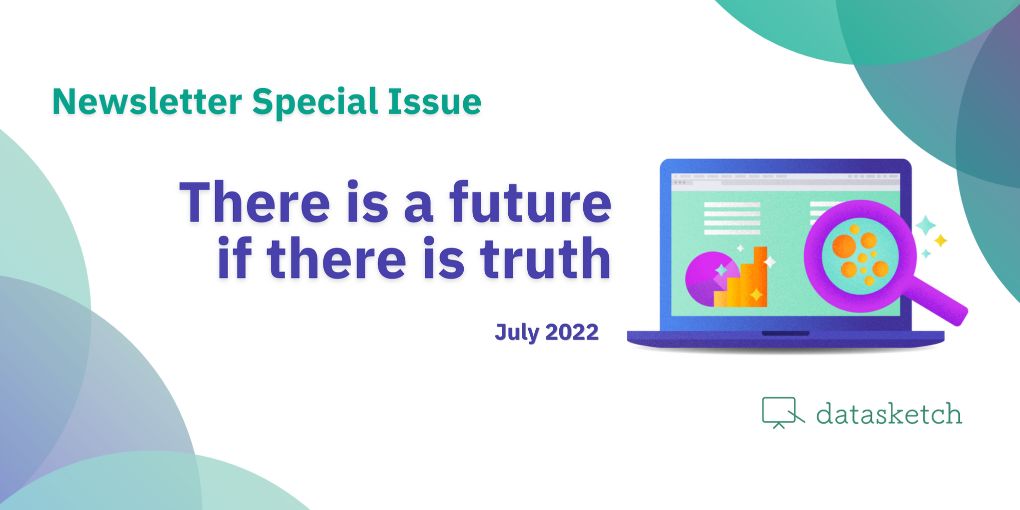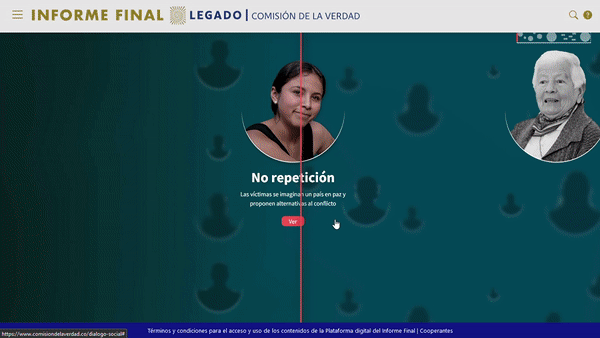There is a future if there is truth
We dedicate a special issue of our newsletters to the final report of the Truth Commission because of its relation to data journalism, openness and access to information, and culture.
Available in:

We are Datasketch.
We welcome you to this special issue. We want you to know the final report of the Commission for the Clarification of the Truth in Colombia. The report is an instrument designed to listen to those who lived the armed conflict directly in the country. We highlight its relationship with data journalism, openness and access to information, and culture.
It is a fundamental exercise for the enlightenment and reconciliation of those who have suffered an armed conflict in the world, especially in Colombia, the country where our main office is located.
What is the Truth Commission?
At the end of 2016, the Colombian Government and the Revolutionary Armed Forces of Colombia (FARC-EP) ratified the Final Agreement for the Termination of the Conflict and the Construction of a Stable and Lasting Peace.
In this context, the Commission for the Clarification of Truth, Coexistence, and Non-Repetition (CEV) was created, a mechanism of the Integral System of Truth, Justice, Reparation, and Non-Repetition. It is an extrajudicial, autonomous, and independent State entity.
Its purpose is to know the truth about what happened in the context of the armed conflict, contribute to the clarification of the violations and infractions committed, and provide a comprehensive explanation of their complexity to the whole society.
And the Report?
On June 28, the Commission made public the so-called “final report”. This document collects more than 30,000 testimonies from different actors who have suffered directly from the Colombian armed conflict and a “multimodal transmedia platform” for its divulgation.
The CEV seeks to promote justice for victims and accountability for human rights violations and breaches of International Humanitarian Law, based on recognizing truth and responsibilities.
It has ten chapters, which will be released within two months of the launch. In addition, in the following seven years, a Follow-up Committee will monitor the recommendations given to the nation and state to avoid the repetition of a new armed conflict.

A sea of data
The document was produced thanks to the collaboration between the Commission, the Special Jurisdiction for Peace (JEP), and Human Rights Data Analysis Group (HRDAG).
Valentina Rozo, HRDAG consultant who worked with Patrick Ball on this project, highlights the enormous data analysis work that supports it. It brought together 112 databases taken from multiple sources that, beyond testimonies, document the victims of the conflict.
The first challenge was data standardization, which they solved through artificial intelligence. The second challenge was underreporting information since not all databases have complete data. They used a statistical imputation of missing fields to solve it, but this system still left victims out. Consequently, they opted for multiple systems estimation to complement the information.
Access the results and graphs:
📖 Findings and recommendations
An open process
The Commission seeks to contribute to a stable and lasting peace through a broad and pluralistic participatory process involving listening to testimonies and accountability. It has also implied the recognition of what happened, based on a series of meetings between victims and those responsible for violent acts. These dialogues have made it possible to humanize a national problem, beyond the bias and narrative of good guys and bad guys, and the search for collective solutions through the recommendations given to the country.
In its platform, we highlight the complete and documented process map. Anyone can access all the procedures, guides, and manuals used. Also relevant is the transparency area, which has all the regulations related to the process. Although this section of the website is a legal mandate, it is surprising how complete and structured it is, as it complies with the principle of transparency.
Truth and culture
Throughout the mandate of the Truth Commission, art has played a notable role in the narration of the events and its healing character. In the words of the CEV: “Art must accompany the transformations”. In this sense, the multimodal transmedia platform has four interactive cultural proposals of textual, sound, and visual records: the exhibitions of Exilio, the sound narrative of Volumen Testimonial, the collection of projects of Activaciones Artísticas y Culturales, and the recordings of A Viva Voz.
The four elements that most attract our attention
The platform and the multiple information dissemination channels show a broad understanding of the problem, which cannot be narrated linearly. Diverse tools such as timelines, maps, and graphs can be found on the platform. This is our top 4 components related to visualizations or stories told with data.
- 🇨🇴 Colombia adentro (Colombia inside) | Storytelling.
- 🗨️ Diálogo social (Social dialogue) | Timeline.
- 🙋🏽♀️🙋🏾♂️ Con quien (With whom) | waffle chart and maps.
- 🗺️ Map Viewer | Maps.
Want to read more?
- Visualizations of human rights violations | La Silla Vacía.
- How to overcome the narrative of good and bad guys in war | El Espectador.




